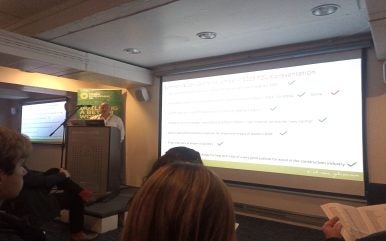
European sawmillers continue to feel the pressure of poor market conditions, while expectations of a big market boost from the UK Government’s ambitious housebuilding agenda are far from certain, key industry speakers told Timber Development UK’s (TDUK) Global Markets Conference.
Construction Productions Association (CPA) economics editor Noble Francis told 200 timber industry representatives at London’s Building Centre on November 6 that while there were positive early signs of improvements in UK construction, the new Government’s housebuilding target of 1.5 million new homes during the next Parliamentary period was “ludicrous”.
The CPA’s forecast for the UK construction sector is officially one of “cautious optimism”. It forecasts UK GDP to be 1.1% in 2024, 1.7% in 2025 and 2.3% in 2026.
Its forecast is for +2.5% in overall UK construction output in 2025. Private housebuilding is forecast to improve 8%.
But the growth has to be seen in the context of the CPA’s forecasted -2.9% in overall construction output in 2024 and -9% in private housebuilding.
He expressed scepticism of the UK Government’s new housing targets. “There is no chance of the Government achieving it. The 1.5 million new homes target is ludicrous.”
He pointed out that the construction sector had lost 385,000 workers since Q1, 2019.
Mr Noble said the CPA was anticipating four interest rate cuts next year.
Meanwhile, fellow TDUK conference speaker Olle Berg, EVP market/sales & business development at Setra Group, said Swedish, Finnish and central European sawmillers were really suffering, with the full force of the downturn being felt in Q2, 2024.
Production rates were being kept low. “There is no sign that this will change,” he said. “Raw material availability will worsen. This is the big talk in the Swedish sawmilling industry.”
He pointed to a huge profitability challenge in the Swedish sawmilling sector. “If this continues it will drive a restructuring of the business.”
“If and when the market picks up, there is very little material to meet that increase in production demand.”
Mr Berg referred to the recent International Softwood Conference, where he said there was “slight optimism” for perhaps a 1% improvement in demand.
“Interest rate development is the single biggest problem for global wood consumption.”
He shared European softwood import statistics which show that imports were down 4% in Europe for the first six months of 2024. The UK specifically saw 2.7 million m3 of softwood imports, down 6% on a year ago.
In 2025, he forecasts a +5% improvement in European softwood imports. European softwood exports to the US were predicted to grow +20% in 2025 (after a -17% reverse in 2024). Overall demand would improve next year, he said, but there would be no building boom. And European sawmills would continue to be under pressure.
Softwood exports to China are at their lowest in 10 years, with Mr Berg explaining that China was having “fundamental problems” in its economy.
US softwood consumption was at healthy levels in 2024 but oversupplied. “The US is looking quite positive; the fundamentals look very good.”
The North Africa/Middle East market was described as the largest overseas market at the moment, with the market predominantly being redwood.
During a panel debate featuring Graham Blyth of James Jones and Sons, Mike Glennon, of Glennon Brothers and Mr Berg, Mr Blyth warned of the erosion of the C16 grade market due to the overspecification of C24, calling for more support for C16.
He also raised concern in the market about credit insurance and private equity ownership in the sector.
Mike Glennon said the biggest issue in Ireland’s elections this month was the housing shortage. He also said tree planting levels needed to increase.
“There is a lack of political understanding that to build more with wood you actually need to plant more trees.”






